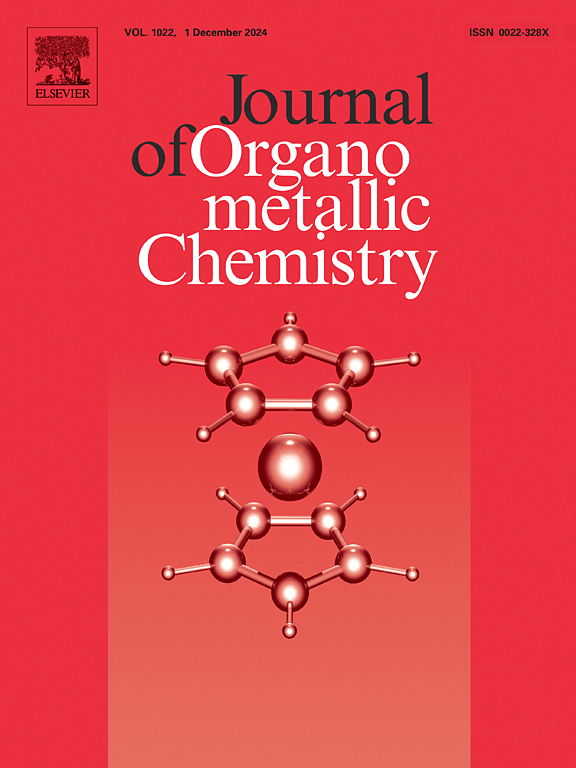Combined In Vitro and In Silico analysis of ferrocenylmethylaniline derivatives: Antibacterial potential, DFT calculations, and molecular dynamics insights
IF 2.1
3区 化学
Q3 CHEMISTRY, INORGANIC & NUCLEAR
引用次数: 0
Abstract
The rise of antimicrobial resistance poses a major public health threat by reducing the efficacy of treatments against infections in humans, animals, and plants. This study evaluates the antibacterial potential of three ferrocenylmethylaniline derivatives: Ferrocenylmethylaniline (FMA), N-Ferrocenylmethyl-N-acetylaniline (FMAA), and N-Ferrocenylmethyl-N-benzoylaniline (FMBA) against four clinically relevant bacterial strains (Escherichia coli (E. coli), Pseudomonas aeruginosa (P. aeruginosa), Klebsiella pneumoniae (K. pneumoniae), and Staphylococcus aureus (S. aureus)). In vitro assays revealed FMBA as the most potent compound, with IC50 values of 26.18 mg/mL (E. coli), 34.33 mg/mL (P. aeruginosa), and 42.08 mg/mL (S. aureus), comparable to amoxicillin (AXL).
Molecular docking against twelve bacterial drug targets showed FMBA exhibited superior binding affinities, particularly with peptide deformylase, anthranilate-CoA ligase, peptidoglycan D,D-transpeptidase, dehydrosqualene synthase, and penicillin-binding protein 2a . DFT analysis, including thermodynamic parameters and non-covalent interactions (Reduced Density Gradient, Electron Localization Function, Localized Orbital Locator), provided deeper insights into electronic structures, stability, and binding interactions. Molecular dynamics simulations confirmed the stability of FMBA-protein complexes, reinforcing its potential as a promising antimicrobial lead compound. These findings suggest FMBA as a strong candidate for the development of novel antibacterial agents targeting drug-resistant pathogens.

二茂铁甲基苯胺衍生物的体外和硅内联合分析:抗菌潜力,DFT计算和分子动力学见解
抗菌素耐药性的上升降低了对人类、动物和植物感染的治疗效果,对公共卫生构成重大威胁。本研究评估了三种二茂铁甲基苯胺衍生物:二茂铁甲基苯胺(FMA)、n -二茂铁甲基- n -乙酰苯胺(FMAA)和n -二茂铁甲基- n -苯甲酰苯胺(FMBA)对四种临床相关菌株(大肠杆菌(E. coli)、铜绿假单胞菌(P. aeruginosa)、肺炎克雷伯菌(K. pneumoniae)和金黄色葡萄球菌(S. aureus))的抑菌潜力。体外实验结果显示,FMBA的IC50值与阿莫西林(AXL)相当,分别为大肠杆菌26.18 mg/mL、铜绿假单胞菌34.33 mg/mL和金黄色葡萄球菌42.08 mg/mL。对12个细菌药物靶点的分子对接表明,FMBA具有优越的结合亲和性,特别是与肽去甲酰基酶、甘油三酯-辅酶a连接酶、肽聚糖D、D-转肽酶、脱氢角鲨烯合成酶和青霉素结合蛋白2a。DFT分析,包括热力学参数和非共价相互作用(降低密度梯度,电子定位函数,局部轨道定位器),提供了对电子结构,稳定性和结合相互作用的更深入的了解。分子动力学模拟证实了fmba -蛋白复合物的稳定性,增强了其作为一种有前景的抗菌先导化合物的潜力。这些发现表明FMBA是开发针对耐药病原体的新型抗菌药物的有力候选者。
本文章由计算机程序翻译,如有差异,请以英文原文为准。
求助全文
约1分钟内获得全文
求助全文
来源期刊

Journal of Organometallic Chemistry
化学-无机化学与核化学
CiteScore
4.40
自引率
8.70%
发文量
221
审稿时长
36 days
期刊介绍:
The Journal of Organometallic Chemistry targets original papers dealing with theoretical aspects, structural chemistry, synthesis, physical and chemical properties (including reaction mechanisms), and practical applications of organometallic compounds.
Organometallic compounds are defined as compounds that contain metal - carbon bonds. The term metal includes all alkali and alkaline earth metals, all transition metals and the lanthanides and actinides in the Periodic Table. Metalloids including the elements in Group 13 and the heavier members of the Groups 14 - 16 are also included. The term chemistry includes syntheses, characterizations and reaction chemistry of all such compounds. Research reports based on use of organometallic complexes in bioorganometallic chemistry, medicine, material sciences, homogeneous catalysis and energy conversion are also welcome.
The scope of the journal has been enlarged to encompass important research on organometallic complexes in bioorganometallic chemistry and material sciences, and of heavier main group elements in organometallic chemistry. The journal also publishes review articles, short communications and notes.
 求助内容:
求助内容: 应助结果提醒方式:
应助结果提醒方式:


